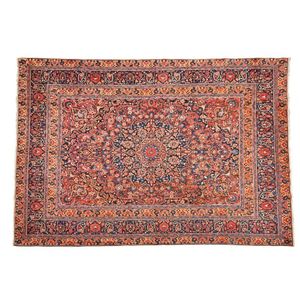Iranian Sultanabad Carpet with Palmettes and Lilies
You must be a subscriber, and be logged in to view price and dealer details.
Subscribe Now to view actual auction price for this item
When you subscribe, you have the option of setting the currency in which to display prices to $Au, $US, $NZ or Stg.
- A/f, as Inspected - The letters "A/F" or "as inspected" as part of a description is the cataloguer's shorthand for "all faults" or "as found", meaning the item has some type of damage or deficiency, it is of uncertain date or provenance, and/or that the seller takes no responsibility for the completeness of the item or the accuracy of the description.
- Herati Design in Persian Carpets - The Herati design has been used in Persian carpet weaving for centuries and is considered a classic. It consists of a repeating pattern of a central diamond or rhombus, surrounded by four curled leaves or petals, with a small flower or rosette in each of the four corners.
The design is sometimes also referred to as the fish pattern, due to the resemblance of the curled leaves or petals to fish, or as the mahi pattern, which means "fish" in Persian. It is believed to have originated in the Herat province of Afghanistan, which was a major centre of carpet weaving in the 19th century.
In addition to its aesthetic appeal, the Herati design also has symbolic significance. The central diamond or rhombus is often interpreted as representing the fish's eye, while the curled leaves or petals represent fish, water, or vegetation. The small flowers or rosettes in the corners are thought to symbolize the four seasons or the four elements.
This item has been included into following indexes:
Visually similar items

A good large hand knotted Persian rug, of ornate Kirman design, with central circular medallion on a scroll and intense floral field. Triple borders of rosettes and boteh leaves, 410 cm x 300 cm

An antique Persian Shirvan all wool rug, the central stepped large gul on a blue ground field displaying abrash and with scattered florals, the red/brown wide dominant guard with herati style repeating florals. 204 cm x 141 cm.

A hand knotted Persian carpet, with overall geometric designs on a red ground. Length 260 cm, width 187 cm

A Sarouk rug, north-west Iran, early 20th century, 218 x 128 cm
